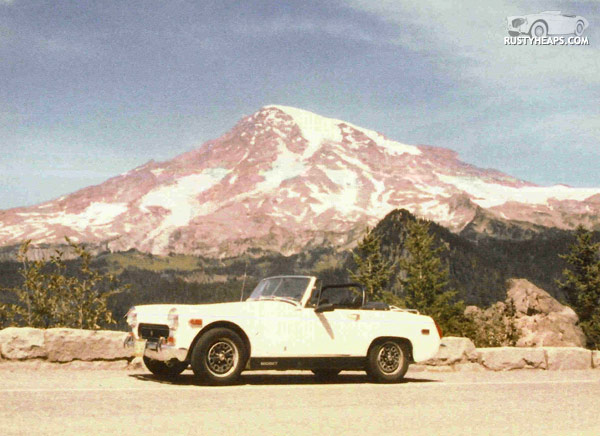This MG Midget was the very first British car I owned. My faithful but abused Toyota was getting pretty long in the tooth, and I was ready for a change–however, whatever British car I bought (and there was no question it would be a British sports car) could only be funded out of the proceeds from the Toyota. That put my budget at $1500 or so.
I must have been 20, as I recall buying it while working for Cipher (where I met my close friend Matt–I’m probably responsible for any automotive indiscretions he has committed over the years).
I really wanted an MGB, but this was just before the Miata appeared–MGBs were still popular despite not having been made for almost ten years. I think $2500 or more was really the entry point for a decent example.
This Midget was advertised in the Times, and my friend Brent and I went to look at it. To say neither of us knew nothing of Midgets or even old British cars in general would be to put it mildly. The owner lived out in Kenmore in an area I probably wouldn’t recognize today, but it was somewhat rural-ish back then.
The car looked OK and seemed to run well. After squeezing in, we took it up the road. There was no syncromesh on first gear–we didn’t know that was supposed to be that way–and thought I had a shrewd bargaining point for my negotiations (the fact that I would consider a car with transmission problems, however non-existent they turned out to be, tells you all you need to know). The little MG started, stopped, looked OK and I–in a pattern which was to repeat itself numerous times over the years, please see the right column–rashly agreed to buy it for $1600.
When I came to collect it, I put the top down and drove off. That was my first time piloting a convertible; it was amazing, an experience which I appreciate even today. I remember feeling incredibly self-conscious, but that wore off pretty quickly. What was left was a remarkable sense of freedom and adventure. In the country it was fun, but in Seattle it was even more fun, being able to look up at the skyscrapers as you drove through town.
My first task when I got home? Removing the “Jesus is Your Friend” license plate frame. I’m already destined for hell according to adherents of that religion, and tossing that frame in the trash probably sealed my fate…
Surprise, surprise, the car was worse than I thought. It was rusty, and someone had liberally applied fibreglass to cover the holes before repainting it. I couldn’t figure out why the driver’s window wouldn’t go down all the way, and I eventually forced it–see the bulging bottom of the door in the photo, that’s the thick fibreglass patch being pushed out.
The throwout bearing disintegrated one night, and I drove it without a clutch over to my good friend Tony’s parents, where that saint, Tony’s father, allowed me to use his tools to fix it. Numerous other things, mostly minor, went bad over the course of the year I had it. I replaced the tires, $35 apiece, one at a time because I couldn’t afford them all at a go. The rear tires were completely bald at one point…
Eventually the motor failed due to the thrust washers dropping into the sump, not uncommon on A-Series engines. I bought a used mill (the “clown motor,” as it was painted in a million different colors) and dropped it in. The car cost me more in parts than the purchase price in the year I had it, and therefore it was one of the few old British cars I’ve had that was a pain in the pocket to own.
I still loved it, though I was happy to “move on up” to an MGB. It was bought by Dusty, a retired Hollywood stunt man, and I wonder if it was saved or eventually scrapped.
